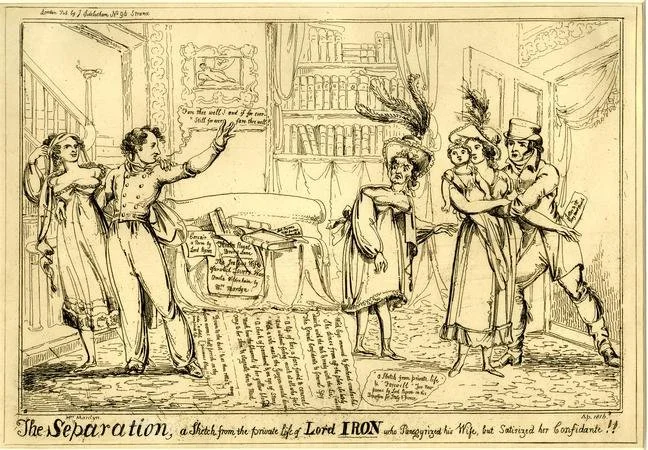Lord Byron: Misunderstood hero or misogynistic bad boy?
The adjective ‘Byronic’ came into the English language in 1823, one year before Lord Byron died of a fever in Greece at 36. For me, the adjective has always carried with it positive connotations. The Byronic hero is one who is moody, conflicted and intense, but also intelligent and noble.
Portrait of George Gordon (1788-1824) 6th Baron Byron of Rochdale in Albanian Dress, 1813 (oil on canvas) by Thomas Phillips.
According to his former mistress Lady Caroline Lamb, Lord Byron was ‘mad, bad and dangerous to know’. She wasn’t wrong there. Not only was Byron rakish and handsome, but apparently the poet was also so incredibly seductive that women were putty in his hands.
Augusta, his half-sister, and five years his senior, didn’t even try to resist his charms, even though she was married. The adultery and incest in which Byron and Augusta indulged was not accidental.
The siblings knew they shared a father (‘Mad Jack’ Byron) and that the other was married. The poet had a wife, Annabella. Augusta’s husband was Colonel George Leigh. Leigh assented to the relationship. He had to; his brother-in-law frequently paid his gambling debts. It is difficult to view Byron’s behaviour sympathetically, however, it was a time when society did not frown upon intermarriage within one’s family. The practise aimed not only to keep but increase family wealth. Literary historians suspect that Byron and Augusta had one child together, Elizabeth Medora.
Byron fled England in 1816 to escape divorce proceedings. His wife, Annabella, who he married for her inheritance (‘Mad Jack’ was a spendthrift and gambler who left his family penniless) aimed three accusations at him. As well as incest (not a crime at the time), she accused him of homosexuality and heterosexual sodomy (both crimes at the time). Also, his violent displays of temper and his unpredictable moods had her believing he was insane.
Byron’s defence? He had married the wrong woman, he claimed, and this drove him to treat Annabella poorly.
It was around this time, during his last months in England, that he seduced Jane Clairmont, stepsister of Mary Godwin. Jane was only eighteen years old. Legend has it, she threw herself at Byron. When he arrived home one afternoon, he found the girl naked in his bed. Perhaps Jane’s behaviour was prompted by her own insecurities. Maybe she was threatened by Mary’s intellect and her relationship with the poet Shelley.
“What could I do? – a foolish girl – in spite of all I could say or do – would come after me – or rather went before me – for I found her here.... I could not exactly play the Stoic with a woman – who had scrambled eight hundred miles to unphilosophize me.”
What could the poor man do?
Not only did he seduce her, but he also persuaded the young and impressionable teenager to use her middle name, Claire. Then he abandoned her and fled the country. Claire was pregnant. Byron would eventually abandon his daughter, too.
For decades, the establishment protected Byron’s reputation. As one of England’s leading poets and a member of the House of Lords, the male elite hoped to conceal his caddish behaviour and his ill-treatment of women.
A satirical sketch by Isaac Robert Cruikshank from 1816
But was Byron the tortured and misunderstood genius as he is often portrayed?
He viewed his club foot as a grotesque deformity that made him insecure and sensitive to ridicule. His licentious behaviour and bravado were merely a display of the poet ‘acting out’. Byron was also prone to gain weight easily and throughout his brief life he embarked on a series of bizarre fad diets, such as the hard biscuit and soda water diet and the use of tobacco as an appetite suppressant. Both his foot and his weight problem he blamed on his mother. The Scottish heiress, Lady Catherine Byron, was overweight, according to her son. Also, she refused to remove her corset throughout her pregnancy, even during her labour! This, Byron believed, was the source of his club foot.
Although Byron is often depicted as a shining light in the Romantic movement, he was anything but romantic to the women in his life. In fact, I believe he despised women just about as much as he despised himself. He had many sexual encounters with maids, servants and groupies who were, in Byron’s words:
“... tooled in a post-chaise - in a hackney coach – in a gondola – against a wall – in a court carriage- in a vis a vis — on a table — and under it.”
That about sums George Gordon Byron, sixth Baron Byron of Rochdale up.
What’s more, his cruel treatment of his wife and the young Claire Clairmont are proof his actions were far from heroic.



